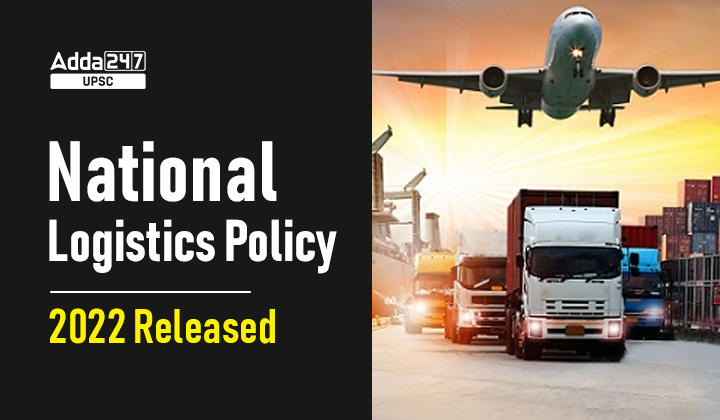Table of Contents
National Logistics Policy (NLP)- Relevance for UPSC Exam
- GS Paper 2: Governance, Administration and Challenges
- Government policies and interventions for development in various sectors and issues arising out of their design and implementation.
National Logistics Policy (NLP) 2022 in News
- Recently, the Prime Minister, Shri Narendra Modi launched the National Logistics Policy (NLP) at Vigyan Bhawan, New Delhi.
- PM Modi called the launch of the National Logistics Policy a significant step in fulfilling the ‘Pran’ of India being a developed country.
National Logistics Policy (NLP)
- Background: Finance Minister Nirmala Sitharaman mentioned the need of a comprehensive National Logistics Policy (NLP) in her Union Budget 2020-21 Speech.
- Need: The need for a national logistics policy was felt since the logistics cost in India is high as compared to other developed economies.
- It is imperative to reduce the logistics cost in India for improving the competitiveness of Indian goods both in domestic as well as export markets.
- Reduced logistics cost improves efficiency cutting across various sectors of the economy, encouraging value addition and enterprise.
- About: National Logistics Policy is a comprehensive effort to address issues of high cost and inefficiency by laying down an overarching interdisciplinary, cross-sectoral and multi-jurisdictional framework for the development of the entire logistics ecosystem,
- Key Objectives: National Logistics Policy 2022 aims to ensure seamless movement of goods and services across the country and cut elevated logistics costs, often considered the biggest structural bottleneck for both external and internal trade in India.
- National Logistics Policy 2022 aims to trim the country’s logistics costs from as much as 13-14 per cent of its GDP to a single digit over the next few years.
- Parent Ministry: The National Logistics Policy formulated by the Commerce and Industry Ministry.
Significance of National Logistics Policy (NLP) 2022
- National Logistics Policy (NLP) will help in improving both, Ease of Doing Business and Ease of Living in India.
- The policy is an endeavour to improve the competitiveness of Indian goods, enhance economic growth and increase employment opportunities.
- National Logistics Policy will complement other initiatives such as PM Gati Shakti Pariyojna and Bharatmala Initiative to to break the silos and improve the logistics efficiency of the country.
- National Logistics Policy 2022 will improve India’s trade competitiveness, create more jobs, improve India’s performance in global rankings and pave the way for India to become a logistics hub.
Key Features of National Logistics Policy (NLP) 2022
New Logistic Policy 2022 has following four critical features-
- Integration of Digital System (IDS):30 different systems of seven different departments will be integrated digitally including the road transport, railway, customs, aviation, foreign trade and commerce ministries.
- It will improve shorter cargo movement.
- Unified Logistics Interface Platform (ULIP):It will bring all the digital services related to the transportation sector into a single portal, freeing the exporters from a host of very long and cumbersome processes.
- It will also lead to smooth cargo movement.
- Ease of Logistics (ELOG):A new policy will be implemented to simplify the rules and ease the logistics business.
- Through this portal, industry associations can directly take up any such matters which are causing problems in their operations and performance with the government agencies.
- A complete system has also been put in place for the speedy resolution of such cases.
- System Improvement Group (SIG):monitoring all logistics-related projects regularly and tackling all obstacles.
Status of logistics Sector in India
- India’s logistics sector is highly defragmented and the aim is to reduce the logistics cost from the present 14% of GDP to less than 10% by 2022.
- India’s logistics sector is very complex with more than 20 government agencies, 40 PGAs, 37 export promotion councils, 500 certifications, 10000 commodities, 160 billion market size.
- It also involves 12 million employment base, 200 shipping agencies, 36 logistics services, 129 ICDs, 168 CFSs, 50 IT ecosystems and banks & insurance agencies.
- Further, 81 authorities and 500 certificates are required for EXIM.
- The Indian logistics sector provides livelihood to more than 22 million people and improving the sector will facilitate 10 % decrease in indirect logistics cost leading to the growth of 5 to 8% in exports.
- Further, it is estimated that the worth of Indian logistics market will be around USD 215 billion in next two years compared to about USD 160 billion at present.




 TSPSC Group 1 Question Paper 2024, Downl...
TSPSC Group 1 Question Paper 2024, Downl...
 TSPSC Group 1 Answer key 2024 Out, Downl...
TSPSC Group 1 Answer key 2024 Out, Downl...
 UPSC Prelims 2024 Question Paper, Downlo...
UPSC Prelims 2024 Question Paper, Downlo...




